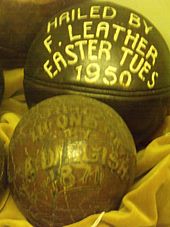 Today's national news included an item on the amount of rubbish and human waste being left on mountains in the Lake District. I have a love of the county of Cumbria; you know..... lakes, mountains and Jennings Bitter. I have also sampled Workington AFC, one of the ex-Football League clubs, that held its own for a while, then faded.
Today's national news included an item on the amount of rubbish and human waste being left on mountains in the Lake District. I have a love of the county of Cumbria; you know..... lakes, mountains and Jennings Bitter. I have also sampled Workington AFC, one of the ex-Football League clubs, that held its own for a while, then faded.
And I have been to Barrow AFC also, as well as a tour around the town's ship and submarine industry!! Barrow, of course, a EFL Div 2 club; yesterday's game a 2-2 draw at Salford City. (Previously in English Football League from 1921-1972.) Barrow's promotion from the National League as Champions in 2020, took them back to the Football League 2, making them the first, and to date only, club to have been promoted back to the Football League having previously lost their league place via the re-election process. On Saturday Sutton United make the journey north! https://www.barrowafc.com/ nickname The Bluebirds due to their chosen kit colours.
Workington AFC, in West Cumbria, has a very nice website which may be viewed on this link: http://www.pitchero.com/clubs/workingtonafc
Known as Workington Reds, the football club has to distiguish itself from the rugby league club that shares the same "stadium", Borough Park. It has a massive capacity of 3,000. Needless to say, you know that Association Football emerged from the mob game, as did rugby. Both were nurtured through the Public Schools and civilised with "laws".
There are no other ostensible rules of play and the game is primarily a rough and tumble scrum interspersed with break-away sprints by members of one team or the other, with some similarities to rugby. Some players from outside Workington take part, especially fellow West Cumbrians from Whitehaven and Maryport, resulting in about a thousand players on each team. Rugby seems to be more popular in the county. The ball is made from four pieces of cow leather. It is 21 inches (53 cm) in circumference and weighs about two and a half pounds (1.1 kg). Only three hand-made balls are produced every year and each is dated. The player who hails the ball gets to keep the ball and will take the ball into the Town centre for people to get photos with for donations.
Uppies and Downies refer to the residents of the top (East) and bottom (West) of the town, which slopes down towards the sea. In the modern incarnation of the game, the Downies were originally residents of the marsh and quay, a working class area of the town demolished in the early 1980s and traditionally looked down at by the more affluent top of the town, where the local petty bourgeoisie lived. Due to its unpredictability, the game can spill over into the town centre. In the past, police have issued safety advice to visitors and local parents warning of getting caught up in the inevitable rough and physical encounter. A pair of coal-black iron-ore coloured figure statues created by Maryport sculptor Colin Telfer depict the Easter mass event; one stands outside Workington Town Hall and the other at the town harbour.
From April 1755 there has been a report of this game known locally as the "Cumbrian paquet". Times have changed and a type of football was played in the 1860s. Some steel workers from Charles Cammel and Co, at Dronfield in Derbyshire arrived in the town in the 1880s and introduced a more formal game. Dronnies formed the team in 1888. The club folded in 1911 and was revitalised in 1921.Workington AFC did not get into the Football League until 1951 replacing New Brighton. For a few months in 1954-5 the team was managed by Bill Shankly. Their stay lasted until 1977 when they were not re-elected and their place taken by AFC Wimbledon. Their most recent result in the Northern Premier League Division One North-West, the 8th Tier, was against Kendal Town, a 2-0 win, at home Borough Park. Come on The Reds!
| Celtic/Roman ball games (Antiquity) | Mob football (Medieval) | Public-school football (Modern) | Cambridge rules (1838–1863) | Association football (1863) |
| 7-a-side | ||||
| Beach (1992) | ||||
| Futsal (1930) | ||||
| Sheffield rules (1857) | ||||
| Indoor | ||||
| Paralympic | ||||
| Street | ||||
| Rugby football (1845) | ||||
| Rugby union (1871) | ||||
| Rugby sevens (1883) | ||||
| Rugby league (1895) | ||||
| Nines | ||||
| Beach rugby | ||||
| Touch football | ||||
| American football (1869) | Arena football (1987) | |||
| Canadian football (1861) | Flag football | |||
| Gaelic (1887) | International rules (1967) | |||
| Australian rules (1859) | ||||



No comments:
Post a Comment